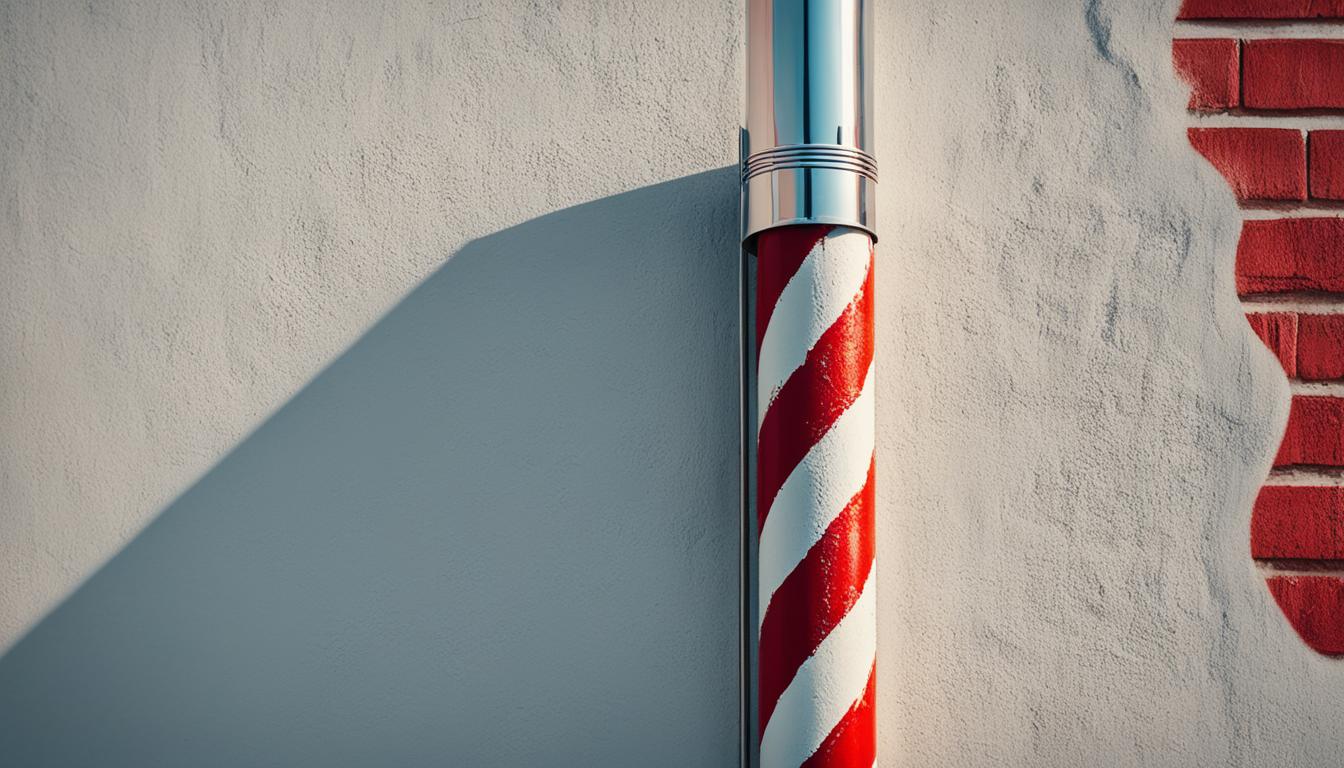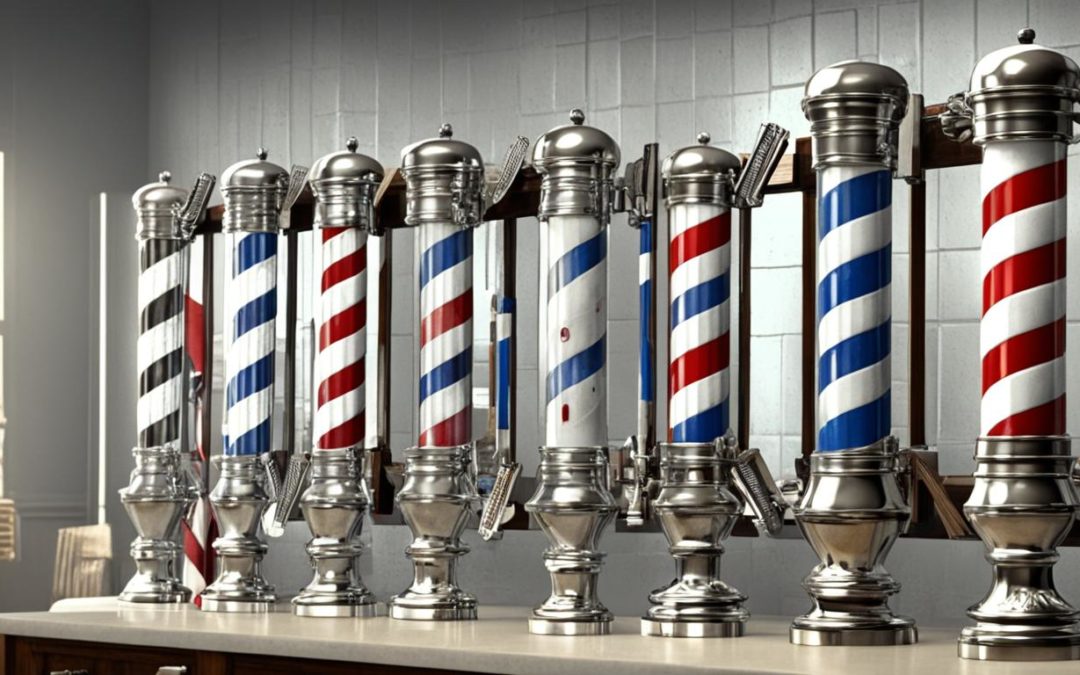Imagine stepping into a barbershop, the smell of freshly cut hair lingering in the air. You settle into the faded leather chair, taking in the old-world charm of the establishment. As the barber skillfully works their magic, your eyes are drawn to the iconic symbol hanging proudly outside the shop – the barber pole.
The barber pole has a fascinating history that dates back to the Middle Ages. During this time, barbers didn’t just offer grooming services; they were also skilled in medical procedures such as bloodletting and surgery. The red and white stripes of the barber pole have their origins in the practice of bloodletting, with the red symbolizing blood and the white representing the bandages used during the procedure. The barber pole itself symbolized the instrument used to encourage blood flow. This historical connection to the medical profession gives the barber pole a unique cultural significance.
Over the centuries, the barber pole has evolved along with the industries it represents. As medical practices advanced, the barber and surgeon professions began to separate, and the blue stripe was added to differentiate barbers from doctors. This addition also pays tribute to the colors of the American flag, according to some historical sources. The barber pole has become synonymous with barbershops, serving as a visual cue for the haircutting tradition and the historical evolution of the barbering industry.
Today, the barber pole continues to hold cultural significance as a nostalgic symbol and a community gathering place for social interactions. It serves as a visual marketing tool, attracting customers to the barbershop and evoking a sense of tradition and authenticity. The future of barbershops looks promising, with the resurgence of traditional men’s grooming and the growth of the barbering industry. The barber pole remains an intriguing and educational resource, shedding light on the history of medicine, visual cues, and the evolution of industries.
Key Takeaways:
- The barber pole originated from the practice of bloodletting in the Middle Ages, symbolizing the instrument used to encourage blood flow.
- The red and white stripes of the barber pole represent blood and bandages, while the blue stripe was added to differentiate barbers from doctors.
- The barber pole holds cultural significance as a nostalgic symbol and a visual marketing tool for barbershops.
- In modern times, the barber pole continues to attract customers and serves as a community gathering place.
- The barber pole is an intriguing and educational resource for exploring the history of medicine and the evolution of industries.
The Origins of the Barber Pole
In the fascinating history of the barber pole, its origins can be traced back to the Middle Ages when barbers held a multifaceted role as dentists and surgeons. During this era, medical care was rudimentary, and bloodletting was a common treatment for various ailments. Barber-surgeons, as they were known, not only performed haircuts and beard trims but also administered medical procedures.
The red and white stripes of the barber pole were inspired by the grueling practice of bloodletting. Barbers would use bandages to dress the wounds caused by the procedure, resulting in blood-soaked white fabric. The red symbolized the blood itself, while the white represented the bandages.
The barber pole served a practical purpose during bloodletting procedures. Patients would grip a staff or pole tightly to encourage blood flow, helping the process achieve its intended outcome. Symbolically, the pole represented the very instrument used during the procedure.
By incorporating the barber pole outside their shops, barbers announced that they were open for business. It was a visual marker that caught the attention of passersby, indicating that barbers were ready to provide their range of services which included not just haircuts but also medical treatments.
The Impact of Medieval Medicine
During the Middle Ages, the practice of medicine was vastly different from what it is today. Barbers, with their knowledge of bloodletting and rudimentary surgical procedures, played a crucial role in the community. The barber pole stands as a testament to the historical significance of their contributions to healthcare during that time.
Barber Poles and the Evolution of Medicine
“The barber pole serves as a powerful symbol, reminding us of the various roles barbers played in society. From healing the sick to providing grooming services, barbers were at the forefront of medical care and are an integral part of our medical history.” – Dr. Elizabeth Price, Historian
Unveiling Cultural Significance
The origins of the barber pole go beyond medical practices; its cultural significance extends to the historical traditions associated with male grooming. Barbershops were more than just places to get a haircut; they served as social hubs where men gathered to socialize, share stories, and interact with their communities.
The Legacy Lives On
Today, the barber pole continues to be an enduring symbol that signifies the traditions and craftsmanship associated with barbershops. It serves as a nostalgic reminder of an era when the local barbershop was not only a place to get a clean shave but also a gathering place for friends and neighbors.
Symbolism and Cultural Significance of the Barber Pole
The red and white stripes of the barber pole symbolize the blood and bandages used during bloodletting, offering a glimpse into the historical association between barbers and medical practices. In Europe, as the barber and physician professions began to separate, a blue stripe was added to differentiate barbers. Interestingly, some historical sources also suggest that the blue stripe was added as a tribute to the colors of the American flag, adding a patriotic touch to the barber pole’s symbolism.
The barber pole holds immense cultural significance as a symbol of the barbershop and the historical traditions associated with male grooming. It represents more than just a visual marketing tool; it serves as a cultural touchstone recognized globally. The iconic red and white stripes, with the addition of the blue stripe, have come to embody the barbershop experience and the sense of nostalgia that accompanies it.
The Barbershop Symbol
The barber pole is not merely a decorative element; it serves as an emblem of community and craftsmanship within the barbershop. Stepping into a barbershop adorned with a traditional barber pole is an invitation to connect with like-minded individuals and become part of a shared experience. It evokes a sense of timeless tradition and a space where men can gather, converse, and bond.
“The barber pole represents the artistry and dedication of barbers, reminding us of the cultural and social significance of this venerated profession. It is a symbol that transcends time and connects us to a rich heritage of male grooming.”
Furthermore, the barber pole acts as a beacon, drawing in customers by visually signaling the services offered within. Its striking design and vibrant colors evoke curiosity and pique interest. It is a symbol that cuts across age, gender, and cultural boundaries, instantly recognizable and universally understood.
Cultural Significance
The barber pole’s cultural significance extends beyond its physical appearance. It represents the bond between the barber and the community, as well as the importance of barbering as a respected profession. For generations, barbershops have been spaces where conversations and stories are shared, where friendships are forged, and where the art of grooming is celebrated.
Today, the barber pole continues to find relevance in a modern society that appreciates tradition and craftsmanship. The symbol remains a constant reminder of the timeless traditions associated with barbershops, offering a nostalgic refuge in a fast-paced world. From its humble origins in bloodletting to its present-day representation of community and grooming excellence, the barber pole stands as a testament to the enduring cultural significance of this iconic symbol.
| Symbolism | Cultural Significance |
|---|---|
| Red and white stripes | Represents blood and bandages used in bloodletting |
| Blue stripe addition | Differentiation from doctors and tribute to the American flag |
| Barbershop symbol | Emblem of community, craftsmanship, and nostalgia |
Evolution of the Barber Pole through History
Throughout history, the design of the barber pole has continuously evolved, reflecting changing cultural trends and advancements in the barbering industry. While the traditional barber pole features helical stripes of red, white, and blue, there have also been regional variations and artistic interpretations of the design.
Regional variations in barber pole designs showcase the diversity and creativity within the trade. Different cultures and communities have added their unique touch to the classic barber pole, incorporating local symbols, colors, and patterns. These variations not only add aesthetic appeal but also provide insights into the regional nuances and traditions associated with hairstyling and grooming.
“The evolution of the barber pole design is a testament to the artistic ingenuity and cultural diversity within the barbering industry.” – Barber Expert
Artistic interpretations of the barber pole have further transformed its appearance, turning it into an iconic symbol of individual barbershops. Talented barbers and artists have added their personal flair to the classic design, creating visually stunning poles that beautifully showcase their craftsmanship and creativity.
Advancements in sanitation practices and medical separation have also played a crucial role in shaping the evolution of the barber pole. As medical knowledge advanced and the importance of cleanliness became more apparent, the barber and surgeon professions began to separate. The barber pole became a symbol of the barbering trade, representing the focus on grooming and aesthetics rather than medical procedures.
The evolution of the barber pole is a testament to the cultural and historical changes within the barbering industry. It highlights the trade’s adaptation to societal advancements and the unique artistic expressions of individual barbers. As barbershops continue to thrive and innovate, the barber pole remains a powerful visual marketing tool, attracting customers with its iconic design and symbolizing the traditions and craftsmanship associated with the trade.
Regional Variations in Barber Pole Designs:
| Region | Variation |
|---|---|
| United States | Red, White, and Blue Stripes in Helical Pattern |
| United Kingdom | Red and White Stripes with No Blue Stripe |
| Italy | Red, White, and Green Stripes |
| Japan | Red and White Stripes with Cherry Blossom Motifs |

Barber Poles in Modern Times and the Future of Barbershops
In modern times, barber poles continue to serve as visual marketing tools, attracting customers to barbershops. The barbershop is more than just a place to get a haircut or shave; it is a community gathering place that fosters social interactions, especially among men.
With the resurgence of traditional men’s grooming and the growth of the barbering industry, the future of barbershops looks promising. Men today value the experience of visiting a barbershop, where they can enjoy the company of others, engage in conversations, and receive personalized grooming services.
 hairstyling and male grooming. Its presence outside a barbershop not only signals that skilled professionals are ready to provide their services but also adds a touch of nostalgia and authenticity to the establishment.
hairstyling and male grooming. Its presence outside a barbershop not only signals that skilled professionals are ready to provide their services but also adds a touch of nostalgia and authenticity to the establishment.
“The barbershop is a place where men can gather, connect, and share their stories while getting a haircut. It’s a unique space that fosters a sense of community and belonging. For many men, it’s more than just a place to groom; it’s a sanctuary where they can relax and be themselves.”
The future of barbershops lies in their ability to adapt to the changing needs and preferences of customers. Barbershops have evolved into more than just places to get a haircut; they offer a wide range of services, from grooming consultations to facial treatments.
As the demand for personalized grooming experiences grows, barbershops have the opportunity to become a one-stop destination for men’s overall well-being. They can provide services such as skincare consultations, beard grooming, and even wellness activities like yoga classes tailored for men’s needs. By embracing innovation and staying true to their core values, barbershops can stay relevant and continue to thrive in the ever-changing landscape of the beauty and wellness industry.
The Benefits of Barbershops as Community Gathering Places
Barbershops have always been more than just spaces for grooming; they are community gathering places where men can come together, bond, and share their experiences. Here are some key benefits that barbershops offer as community hubs:
- Opportunity for social interaction and camaraderie among men.
- A safe and comfortable environment for men to discuss personal issues and seek support.
- Mentorship and guidance from experienced barbers who serve as role models.
- A source of knowledge and advice on grooming, style, and overall well-being.
The Role of Visual Marketing in Attracting Customers
Visual marketing plays a crucial role in attracting customers to barbershops. The iconic barber pole serves as a powerful visual cue that instantly communicates the presence of a barbershop to passersby. The striking combination of red, white, and blue evokes a sense of professionalism, tradition, and nostalgia.
Additionally, barbershops can leverage visual marketing strategies to create eye-catching window displays, appealing signage, and engaging social media content. By showcasing their services, expertise, and unique atmosphere through visually compelling imagery and videos, barbershops can capture the attention of potential customers and build brand recognition.
The Future of Barbershops in a Digital Era
| Opportunities | Challenges |
|---|---|
| Incorporating technology for online bookings and appointment management | Competition from online grooming services and home grooming products |
| Expanding services to include wellness and self-care offerings | Adapting to changing trends and customer preferences |
| Cultivating a loyal customer base through personalized experiences | Maintaining high levels of professionalism and expertise |
| Embracing sustainability and eco-friendly practices | Addressing the impact of the COVID-19 pandemic on business operations |
As the future of barbershops unfolds, it is essential for industry professionals to stay informed about emerging trends, technological advancements, and customer expectations. By embracing innovation, fostering a sense of community, and providing exceptional grooming experiences, barbershops can continue to thrive and shape the future of the grooming industry.
Conclusion
The rich history of the barber pole, with its origins in bloodletting and its evolution as a symbol of the barbering industry, provides an intriguing glimpse into the past. From its humble beginnings as a tool for medical procedures, the barber pole has come to represent the traditions and cultural significance of the barbershop.
Today, the barber pole still serves as a visual marketing tool, attracting customers to barbershops and creating a sense of nostalgia. But beyond its role in advertising, the barber pole is also an educational resource. It offers insights into the history of medicine, with bloodletting and surgical practices being central to its origins.
Furthermore, the barber pole highlights the importance of visual cues and their impact on industries. It showcases how a simple symbol can transcend time and become a recognized cultural icon. Exploring the history of the barber pole not only sheds light on the past but also sparks curiosity and encourages further exploration into the evolution of industries as a whole.

